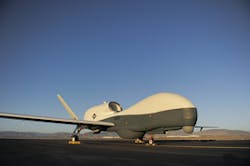PALMDALE, Calif., 16 June 2012. Northrop Grumman Corporation (NYSE:NOC) unveiled the MQ-4C Triton Broad Area Maritime Surveillance Unmanned Aerial Vehicle (BAMS UAV) to the U.S. Navy in a ceremony today at Northrop Grumman's Palmdale, Calif., manufacturing facility.
The Northrop Grumman BAMS UAV is a maritime intelligence, surveillance and reconnaissance system designed to support a variety of missions while operating independently or in collaboration with other fleet assets. When operational, BAMS will provide commanders with a persistent picture of surface threats, covering areas of open ocean and littoral regions as the unmanned segment of the Navy's Maritime Patrol Reconnaissance Force.
Designated the MQ-4C, the U.S. Navy released the aircraft name as Triton, keeping with the tradition of naming surveillance aircraft after Greek gods of the ocean. Triton is the Greek messenger of the sea.
The MQ-4C is designed to stay in the air for 30 hours at a time and fly at a speed of 357 miles per hour. The MQ-5C requires a ground crew of four personnel. The UAV has communication relay capabilities, beyond line-of-sight communications and many different systems for sensing and identifying threats.
Currently, BAMS-D (demonstrator), a Block 10 RQ-4 equipped with maritime sensors, is being used by the U.S. Navy's Fifth Fleet. BAMS-D provides a glimpse of the persistent capabilities that the Triton's 360-degree Multi-Function Active Sensor (MFAS) radar will bring. The MFAS radar is produced by Northrop Grumman Electronic Systems.
The BAMS UAV program is managed by the Navy's Program Executive Office (Unmanned Aviation and Strike Weapons), Persistent Maritime Unmanned Aircraft Systems Program Office (PMA-262), at Naval Air Station Patuxent River, Md.
